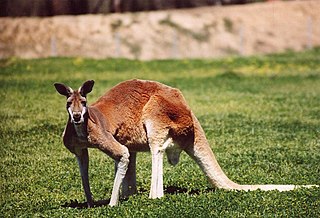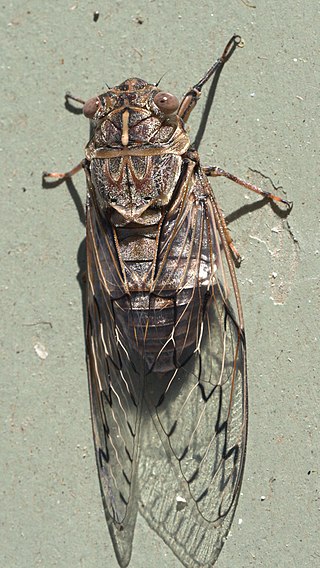Related Research Articles

The Territory of Christmas Island is an Australian external territory in Southeast Asia comprising the island of the same name. It is located in the Indian Ocean around 350 kilometres south of Java and Sumatra and about 1,550 km (840 nmi) northwest of the closest point on the Australian mainland. It has an area of 135 square kilometres (52 sq mi).

Kangaroos are four marsupials from the family Macropodidae. In common use the term is used to describe the largest species from this family, the red kangaroo, as well as the antilopine kangaroo, eastern grey kangaroo, and western grey kangaroo. Kangaroos are indigenous to Australia and New Guinea. The Australian government estimates that 42.8 million kangaroos lived within the commercial harvest areas of Australia in 2019, down from 53.2 million in 2013.

The koala, sometimes called koala bear, is an arboreal herbivorous marsupial native to Australia. It is the only extant representative of the family Phascolarctidae and its closest living relatives are the wombats. The koala is found in coastal areas of the mainland's eastern and southern regions, inhabiting Queensland, New South Wales, Victoria, and South Australia. It is easily recognisable by its stout, tailless body and large head with round, fluffy ears and large, dark nose. The koala has a body length of 60–85 cm (24–33 in) and weighs 4–15 kg (9–33 lb). Fur colour ranges from silver grey to chocolate brown. Koalas from the northern populations are typically smaller and lighter in colour than their counterparts further south. These populations possibly are separate subspecies, but this is disputed.

Marsupials are any members of the mammalian infraclass Marsupialia. All extant marsupials are endemic to Australasia, Wallacea and the Americas. A distinctive characteristic common to most of these species is that the young are carried in a pouch. Living marsupials include kangaroos, koalas, opossums, Tasmanian devils, wombats, wallabies, and bandicoots among others, while many extinct species, such as the thylacine, Thylacoleo, and Diprotodon, are also known.

A raven is any of several larger-bodied passerine bird species in the genus Corvus. These species do not form a single taxonomic group within the genus. There is no consistent distinction between crows and ravens. Names are assigned to different species chiefly based on their size.

Banksia is a genus of around 170 species of flowering plants in the family Proteaceae. These Australian wildflowers and popular garden plants are easily recognised by their characteristic flower spikes, and woody fruiting "cones" and heads. Banksias range in size from prostrate woody shrubs to trees up to 30 metres (100 ft) tall. They are found in a wide variety of landscapes: sclerophyll forest, (occasionally) rainforest, shrubland, and some more arid landscapes, though not in Australia's deserts.

The sugar glider is a small, omnivorous, arboreal, and nocturnal gliding possum. The common name refers to its predilection for sugary foods such as sap and nectar and its ability to glide through the air, much like a flying squirrel. They have very similar habits and appearance to the flying squirrel, despite not being closely related—an example of convergent evolution. The scientific name, Petaurus breviceps, translates from Latin as "short-headed rope-dancer", a reference to their canopy acrobatics.

The fauna of Australia consists of a large variety of animals; some 46% of birds, 69% of mammals, 94% of amphibians, and 93% of reptiles that inhabit the continent are endemic to it. This high level of endemism can be attributed to the continent's long geographic isolation, tectonic stability, and the effects of a unique pattern of climate change on the soil and flora over geological time. A unique feature of Australia's fauna is the relative scarcity of native placental mammals. Consequently, the marsupials – a group of mammals that raise their young in a pouch, including the macropods, possums and dasyuromorphs – occupy many of the ecological niches placental animals occupy elsewhere in the world. Australia is home to two of the five known extant species of monotremes and has numerous venomous species, which include the platypus, spiders, scorpions, octopus, jellyfish, molluscs, stonefish, and stingrays. Uniquely, Australia has more venomous than non-venomous species of snakes.

Eucalyptus is a genus of more than 700 species of flowering plants in the family Myrtaceae. Most species of Eucalyptus are trees, often mallees and a few are shrubs. Along with several other genera in the tribe Eucalypteae, including Corymbia and Angophora, they are commonly known as eucalypts. Plants in the genus Eucalyptus have bark that is either smooth, fibrous, hard or stringy, the leaves have oil glands, and the sepals and petals are fused to form a "cap" or operculum over the stamens. The fruit is a woody capsule commonly referred to as a "gumnut".

Sorghum or broomcorn is a genus of about 25 species of flowering plants in the grass family (Poaceae). Some of these species are grown as cereals for human consumption, in pastures for animals as fodder, and as bristles for brooms. Sorghum grain is a nutritious food rich in protein, dietary fiber, B vitamins, and minerals.

Huntsman spiders, members of the family Sparassidae, are known by this name because of their speed and mode of hunting. They are also called giant crab spiders because of their size and appearance. Larger species sometimes are referred to as wood spiders, because of their preference for woody places. In southern Africa the genus Palystes are known as rain spiders or lizard-eating spiders. Commonly, they are confused with baboon spiders from the Mygalomorphae infraorder, which are not closely related.

Threatened species are any species which are vulnerable to extinction in the near future. Species that are threatened are sometimes characterised by the population dynamics measure of critical depensation, a mathematical measure of biomass related to population growth rate. This quantitative metric is one method of evaluating the degree of endangerment.

Acacia, commonly known as the wattles or acacias, is a large genus of shrubs and trees in the subfamily Mimosoideae of the pea family Fabaceae. Initially, it comprised a group of plant species native to Africa and Australasia. The genus name is Neo-Latin, borrowed from the Greek ἀκακία, a term used by Dioscorides for a preparation extracted from the leaves and fruit pods of Vachellia nilotica, the original type of the genus. In his Pinax (1623), Gaspard Bauhin mentioned the Greek ἀκακία from Dioscorides as the origin of the Latin name.

Australia, officially the Commonwealth of Australia, is a sovereign country comprising the mainland of the Australian continent, the island of Tasmania, and numerous smaller islands. Australia is the largest country by area in Oceania and the world's sixth-largest country. Australia is the oldest, flattest, and driest inhabited continent, with the least fertile soils. It is a megadiverse country, and its size gives it a wide variety of landscapes and climates, with deserts in the centre, tropical rainforests in the north-east, tropical savannas in the north, and mountain ranges in the south-east.

The flora of Australia comprises a vast assemblage of plant species estimated to over 21,000 vascular and 14,000 non-vascular plants, 250,000 species of fungi and over 3,000 lichens. The flora has strong affinities with the flora of Gondwana, and below the family level has a highly endemic angiosperm flora whose diversity was shaped by the effects of continental drift and climate change since the Cretaceous. Prominent features of the Australian flora are adaptations to aridity and fire which include scleromorphy and serotiny. These adaptations are common in species from the large and well-known families Proteaceae (Banksia), Myrtaceae, and Fabaceae.
The Australian Faunal Directory (AFD) is an online catalogue of taxonomic and biological information on all animal species known to occur within Australia. It is a program of the Department of Climate Change, Energy, the Environment and Water of the Government of Australia. By May 12, 2021, the Australian Faunal Directory has collected information about 126,442 species and subspecies. It includes the data from the discontinued Zoological Catalogue of Australia and is regularly updated. Started in the 1980s, it set a goal to compile a "list of all Australian fauna including terrestrial vertebrates, ants and marine fauna" and create an "Australian biotaxonomic information system". This important electronic key and educative package enables faster and orderly identification of Australian centipede species.

Henicopsaltria eydouxii, commonly known as the razor grinder, is a large species of cicada native to eastern Australia. Predominantly brown in colour, it is found in dry and wet sclerophyll forest in December and January and is quite common in Brisbane.

Henicopsaltria is a genus of cicada in the cryptotympanini tribe of the Cicadinae subfamily. Four species have been described. The razorgrinder is the type species.
Henicopsaltria kelsalli, commonly known as the Cape York grinder, is a large species of cicada native to the Cape York Peninsula in northeastern Australia.
Henicopsaltria danielsi, commonly known as the McIvor River grinder, is a large species of cicada found near Cooktown in northeastern Australia.
References
- ↑ Australian Biological Resources Study (14 May 2012). "Species Henicopsaltria rufivelum Moulds, 1978". Australian Faunal Directory. Canberra, Australian Capital Territory: Department of the Environment, Water, Heritage and the Arts, Australian Government. Retrieved 5 December 2017.